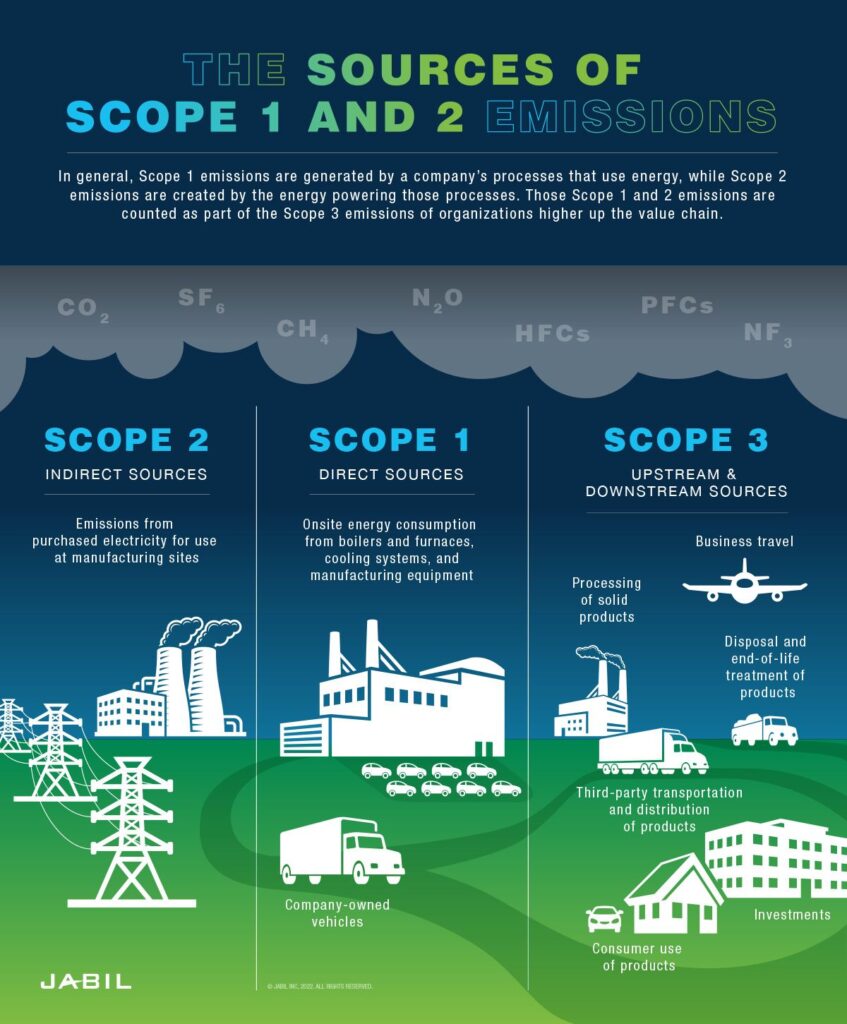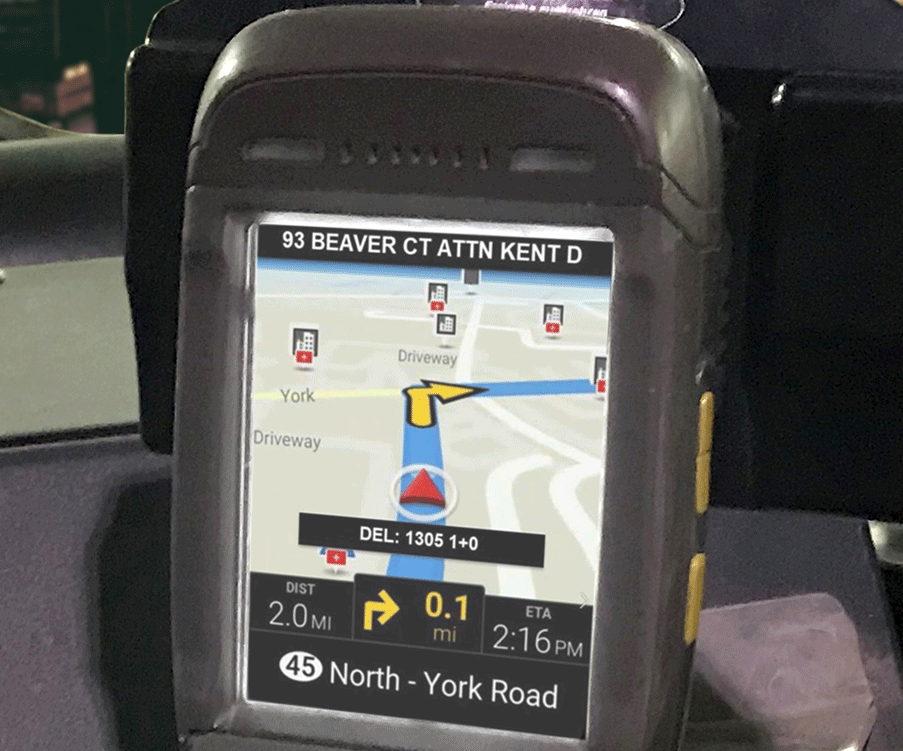Fleet managers face mounting pressure to quantify and reduce their organization's Scope 1 emissions, which often represent the largest source of direct greenhouse gas emissions.
As regulations tighten and sustainability goals become more ambitious, telematics systems and route optimization software offer powerful tools to tackle this challenge.
By providing comprehensive data on fuel usage, driver behavior, and vehicle performance, these technologies enable fleets to make data-driven decisions that simultaneously cut emissions, improve efficiency, and reduce costs.
Enhancing Sustainability to Lower Scope 1 GHG Emissions
Due to increasing regulations, reducing emissions has been brought to the forefront for many companies. There are three different types of emissions companies need to be aware of— Scope 1, Scope 2, and Scope 3. In this article we will focus solely on Scope 1.

infographic source: Jabil
Scope 1 emissions refer to direct greenhouse gas (GHG) emissions that occur from sources owned or controlled by an organization, including all GHGs emitted through the burning of different fuels by owned, leased, on-road, or off-road vehicles.
Fleets are often the largest contributors to an organization’s Scope 1 emissions. As such, fleet managers play a crucial role and frequently face significant pressure from federal regulations or to meet their organization’s sustainability goals to quantify and decrease these emissions.
Incorporation into a continuous improvement plan can lead to a substantial reduction in their operations' environmental footprint. Paramount in this endeavor is the integration of telematics systems and route optimization through transportation management systems (TMS) and fleet management software.
This integration is not just about reducing emissions and fuel consumption but also about empowering fleet managers to improve operational efficiency, thereby significantly impacting the organization's sustainability goals.
"Fleet managers play a crucial role and frequently face significant pressure from federal regulations or to meet their organization’s sustainability goals to quantify and decrease these emissions."
Telematic Systems
Telematics is a digital co-pilot for vehicles, combining telecommunications and informatics to track, analyze, and communicate crucial information about fleet operations.
When added to your fleet integrated systems, telematics systems provide a dynamic solution for fleets to address Scope 1 GHG emissions by offering a 360-degree view of fleet operations.
Key benefits include:
- Optimized routes
- Monitored fuel efficiency
- Timely deliveries
- Cost reduction
How Can Telematics Help Reduce Scope 1 Emissions?
Telematics data enables fleets to make informed decisions to reduce fuel consumption, optimize maintenance needs, and improve driver behavior. This contributes to reducing Scope 1 emissions, such as vehicle tailpipe emissions or maintaining a sleeper cab's heating and cooling system.
The process of determining GHG emissions from a collection of vehicles involves accumulating data on:
- Quantity of fuel used
- Distance traveled
- Unique properties of the fuel for each vehicle
Fleet telematics supplies this data and provides trends on fuel usage patterns and instances of refueling.
Further Benefits of Telematics
Telematics ensures safety and compliance by tracking driver hours, monitoring speed, and facilitating regulatory compliance. While at first glance, this does not seem to affect emissions, according to a study conducted by MIT, improved driving behavior can lead to a 5-10% reduction in emissions.
When evaluating telematics systems, fleets should prioritize features such as real-time tracking, driver behavior monitoring, fuel efficiency optimization, and seamless integration with TMS or fleet software for enhanced fleet management and reduced GHG emissions.
"According to a study conducted by MIT, improved driving behavior can lead to a 5-10% reduction in emissions."
Real-World Example
UPS has implemented a sophisticated TMS and telematics system known as ORION (On-Road Integrated Optimization and Navigation). They report that ORION has reduced their fuel consumption by more than 10 million gallons annually, equivalent to a reduction of 100,000 metric tons of CO2 emissions.

source: UPS
Route Optimization
Route Optimization enables companies to plan more efficient routes, reduce fuel use, and minimize vehicle wear and tear.
By leveraging this software, fleets can achieve:
- Significant savings
- Improved speed
- Enhanced operational efficiency
"Adopting route optimization software facilitates the planning of more efficient routes, resulting in reduced fuel use, minimized vehicle wear and tear, and enhanced operational efficiency."
Four Ways Route Optimization Help Reduce Scope 1 Emissions
- Fleet managers can implement strategies to reduce costs and emissions while ensuring the optimal allocation of human resources by planning more efficient routes.
- Digital route planning drastically reduces the time required for route optimization, allowing for frequent rebalancing of routes and faster deliveries, which further contributes to reducing GHG emissions. Route optimization can ultimately lead to a 15-25% reduction in the total distance traveled. This not only reduces fuel consumption but also cuts emissions proportionally.
- By leveraging telematics data, fleets can make informed decisions to minimize fuel consumption, optimize maintenance needs, and enhance driver behavior, leading to significant reductions in GHG emissions.
- The seamless integration of telematics systems with fleet and transportation management systems offers a comprehensive view of fleet operations, enabling fuel efficiency monitoring and regulatory compliance. Additionally, adopting route optimization software facilitates the planning of more efficient routes, resulting in reduced fuel use, minimized vehicle wear and tear, and enhanced operational efficiency.
Key Takeaways
- Integrating telematics data with route optimization software provides real-time visibility into fleet performance, allowing managers to compare planned routes against actual execution and proactively address issues.
- The combination of telematics and route optimization enables more accurate ETAs, enhancing customer service by reducing surprises and allowing for timely notifications about potential delays.
- Analyzing the integrated data helps identify root causes of deviations from planned routes, enabling fleet managers to improve future route planning and operational efficiency.
Conclusion
Considering the critical factors outlined for telematics system integration and route optimization, fleet managers must select software to optimize environmental impact and ensure compliance with emissions regulations.
By prioritizing emission monitoring, fuel efficiency optimization, and maintenance alerts, fleet managers can make significant strides in reducing GHG emissions and promoting sustainable fleet operations.
Kimberly Lynch, a Senior Business Consultant at JBF Consulting, brings over a decade of expertise in transforming logistics systems. With a profound understanding of the Warehouse/Distribution and Transportation Industry, she excels in guiding organizations of all sizes and industries in selecting, implementing, and optimizing their logistics solutions. Kimberly has successfully managed various Transport Management Systems (TMS) on a global scale, including Blue Yonder TMS and BOLT System, collaborating seamlessly across international and interdisciplinary teams.